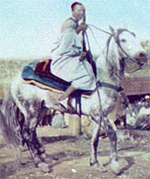The March on Washington
From the Library of Congress:
"The works of photographer Leonard Freed, specifically the photo essay "This Is the Day" about the 1963 March on Washington, is the subject of a lecture and discussion."
From the Library of Congress:
"The works of photographer Leonard Freed, specifically the photo essay "This Is the Day" about the 1963 March on Washington, is the subject of a lecture and discussion."

This photograph archive contains more than 900 images made by American photographer William Henry Jackson (18431942) during his tour of North Africa, Asia, Russia, Australia, and Oceania from 1894 to 1896. The World's Transportation Commission, an organization formed to aid American business interests abroad, commissioned Jackson for this trip.
The photographs, originally exhibited in Chicago's Field Columbian Museum, focus on transportation systems, especially railroads, as well as tourist sites, indigenous life, wildlife, and locations of natural beauty. Nearly 687 of the images are from lantern slides, many of which were hand-colored. Many of the photographs appeared in Harper's Weekly. This collection is valuable for those interested in late 19th-century photography, colonialism, and industrialization.

Furnishes 64 photographs taken by Lewis W. Hine (18741940) between 1908 and 1912. Images document American children working in mills, mines, streets, and factories, and as "newsies," seafood workers, fruit pickers, and salesmen. The website also includes photographs of immigrant families and children's "pastimes and vices."
Original captions by Hine—one of the most influential photographers in American history—call attention to exploitative and unhealthy conditions for laboring children. A background essay introduces Hine and the history of child labor in the United States. This is a valuable collection for studying documentary photography, urban history, labor history, and the social history of the Progressive era.
Wes Cowan of PBS's History Detectives learns about the role of aerial reconnaissance and aerial photography in the Cuban Missile Crisis.
Wes Cowan of PBS's History Detectives discusses the work of photographers during the Civil War, including how photographers manipulated reality in constructing their shots.
Author John Hanson Mitchell outlines his discovery of 2,000 antique glass plate negatives by a previously unknown 19th-century African-American landscape photographer, Robert Alexander Gilbert. Mitchell presents slides of Gilbert's work, and discusses what is known of Gilbert's life.
A slideshow gives examples of presidential photography by three White House photographers: Cecil Stoughton, photographer for Kennedy and Johnson; David Hume Kennerly, for Ford; and Diana Walker, for Reagan and Bush, Sr. The presentation also includes photo coverage and commentary on other presidents, including Clinton and a discussion with the photographers which follows the slideshow.
Author Zoe Trodd follows the history of protest literature in the United States, looking at its use in movements ranging from pre-Revolutionary War to the present day. The presentation also includes Adoyo Owuor reading the Emancipation Proclamation, Timothy Patrick McCarthy reading Eugene v. Debs Statement to the Court, John Stauffer displaying a collection of 20th-century protest photography, and Doric Wilson presenting excerpts from his play Street Theater.
An mp3 of the presentation may be downloaded.
Curator and conservator Grant Romer talks about the formation and work of the Boston photography partners Albert Sands Southworth and Josiah Johnson Hawes and their studio on Tremont Row. Romer looks at the architecture of Tremont Row and how it impacted the work of the partners. His presentation includes slides.
Audio and video options are available.
According to the History of Photography Podcasts website, "One of the great characters in the history of the medium, Alfred Stieglitz was also one of the most influential photographers and promoters of photography of the 20th century. In this presentation, professor Jeff Curto looks at Stieglitz and the group of photographers and other artists he gathered around him. He also tries to examine why what Stieglitz did and what he said were often two different things."